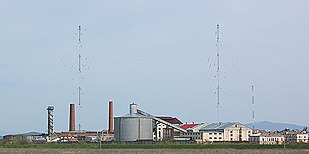Sender Bod
|
Long wave transmitter Bod
also transmitter Brașov Stația de emisie de la Bod
|
||
|---|---|---|
| Basic data | ||
| Place: | Bod | |
| Country: | Romania | |
| Coordinates: 45 ° 45 ′ 17 ″ N , 25 ° 36 ′ 24 ″ E | ||
| Use: | Broadcasting station | |
| Data on the transmission system | ||
| Construction time: | 1929 | |
| Operating time: | 1929– | |
| Waveband : | Long wave and medium wave | |
| Radio : | Long wave broadcasting and medium wave broadcasting | |
| Position map | ||
|
|
||
The long-wave transmitter Bod (also known as Sender Brașov ) is a large transmission facility for long and medium wave near Bod (Brenndorf) , north of Brașov (Kronstadt) , in Romania .
Since the shutdown of the Donebach station, which operates on the same frequency, on January 1, 2015, the Bod station can also be received with good quality at night in Germany.
history
The history of the long-wave transmitter in Bod began in 1929, when Romania put a so-called radio telegraphy system from Germany into operation that had been captured during the First World War . This consisted of two 40 meter high telescopic masts with a 750 watt transmitter. With this system, a suitable transmitter location was sought by means of field measurements on the frequency 156 kHz, which should guarantee perfect ground conductivity. In 1931 a good location was found in Feldioara (Marienburg) , which, however, could not be used because the property owner did not want to sell the property, which was perceived as ideal. So an alternative location had to be found and it was finally found a short time later in Bod.
A provisional transmitter antenna was now being erected in Bod, which was suspended from two 40-meter-high pine masts. This transmitter could emit a power of 20 kilowatts .
However, according to the current legal situation, the distribution of the program was illegal, as Romania had not yet received an officially assigned long wave frequency at that time. Initially, however, it was decided not to assign a long-wave frequency to Romania, but a short time later Romania was provisionally assigned the frequency 235 kHz as a result of the preparations for the Lucerne Wave Plan . However, due to good results in the test broadcasts, Romania wanted to have a frequency in the lower longwave band. However, the desired frequency of 160 kHz was already used by the Netherlands and could therefore not be assigned to Romania. When the Lucerne Wave Plan came into force on January 15, 1934, Romania was assigned the frequency of 160 kHz. The Netherlands had no further interest in this frequency and did not sign this contract.
In 1933, based on a design by the Romanian radio technician Gheorghe Cartianu-Popescu, construction began on the first permanent transmitter in Bod. The parts for the transmitter were supplied by the Italian radio pioneer Guglielmo Marconi . The then high groundwater level offered good conditions for spreading, but caused complications in the construction of the plant. The transmitter building had to be placed on 15 meter long impregnated oak trunks. In January 1935, the transmission system, consisting of two 225-meter-high transmission masts stretched across seven levels, was largely completed and went into operation on January 1, 1936 as one of the most powerful long-wave transmitters on the 160 kHz frequency. The transmitter has three 700 horsepower strong diesel generators powered, since there was no adequate power in Bod then.
In 1941 the station was briefly occupied by enemy legionnaires due to the takeover of large parts of Transylvania by Hungary , but largely not damaged. Only one mast was destroyed in a bombing and rebuilt in 1946.
When the Copenhagen Wave Plan came into force on March 15, 1950, the frequency was changed from 160 kHz to 155 kHz.
In 1965 a new 1,200-kilowatt transmitter was installed by Thomson-Houston and the antenna system was converted. The transmitting antenna now consisted of two braced steel truss masts , each 250 meters high , which have a roof capacity between the mast tips and together result in a folded monopoly.
On February 1, 1986, with the entry into force of the Geneva Wave Plan, the frequency was changed from 155 kHz to the current frequency of 153 kHz.
In 2003, the old transmitter from 1965 was replaced by a new fully transistorized transmitter from Harris , which can only transmit with an output of 200 kilowatts.
Since 2008, the first program of the Romanian broadcaster România Actualități has not been broadcast predominantly via the station . Instead, the majority broadcast Antena Satelor (dt. Village radio), which is aimed at the rural population and mainly broadcasts a music program with Romanian folklore . Since then, Antena Satelor has broadcast from 5 a.m. to 9 p.m., România Actualități from 9 p.m. to 5 a.m. Later, Antena Satelor's airtime was extended to 24 hours and România Actualități was taken off the longwave entirely.
There is also a medium-wave transmitter on the premises , the antenna of which consists of a guyed steel lattice mast that is located directly next to the long-wave antenna . It is transmitted on the frequency 1197 kHz with an output of 14 kilowatts.

